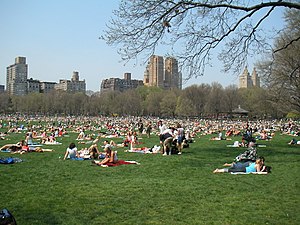Sheep Meadow
However, Central Park's designers Frederick Law Olmsted and Calvert Vaux opposed the use of the meadow for military purposes, so it was instead converted to a pasture with sheep.
Though sports and gatherings were gradually allowed through the late 19th century, Sheep Meadow saw significant deterioration because of overuse.
29–30 [2][3] The winning design was Frederick Law Olmsted and Calvert Vaux's Greensward Plan, whose name referenced a nineteenth-century term for broad open lawns.
[5] When the location of Sheep Meadow was decided, some small communities of poorer New Yorkers were uprooted, including Irish, Germans and African-Americans.
Additionally, large boulders and a rocky ridge that stood 16 feet (4.9 m) out of the finished grade were blasted out, and the reshaped landscape was covered with topsoil.
[4] It was the largest meadow in Central Park until the old Croton Aqueduct collecting reservoir was emptied and made into the Great Lawn in 1937.
[13][14] The sheep were housed in a fanciful Victorian-style sheepfold created in 1870 by Jacob Wrey Mould under the direction of Calvert Vaux.
[13][18] By the 1870s, the park's patronage increasingly came to include the middle and working class, and strict regulations were gradually eased, such as those against public gatherings.
[20] Though certain sports such as lacrosse, tennis, American football, and roller skating were allowed during the 1880s, the commissioners were still reluctant to repeal the "keep off the grass" rules.
[35] With the help of James Taylor, who held a free benefit concert that July,[36][37] the city renovated the meadow and installed a sprinkler system beginning in September 1979.
The project, funded from a grant by the Marc Haas Foundation, was completed in five months, and Sheep Meadow reopened in April 2001.
[46] In 1865, Vaux and Mould designed the Moorish-style Mineral Springs Pavilion at the northwestern edge of Sheep Meadow.
[47] The Mineral Springs Pavilion had cusped arches supported on slender colonnettes, and flaring, complex roofs, reminiscent of Saracenic architecture.
[52] Indian Hunter (1869), created by American sculptor John Quincy Adams Ward, is on the east side of Sheep Meadow near the Mall.
[28][39] The perimeter contains signs saying that team sports, ballplaying, bike riding, skating, glass bottles and dogs are prohibited.
[23]: 10 (PDF p. 7) In the early 20th century, the flock of sheep started sharing space with a variety of festivals and children's pageants, though political protests were not yet permissible.
[17][59] Starting in 1935, troupes of schoolgirls from the city's five boroughs competed at an annual concert attended by thousands of spectators.
In 1916, the 107th Infantry, the 7th Regiment Reserves, marched daily from their Park Avenue Armory to Sheep Meadow for maneuvers and drill, before being deployed that August.
[73] In Easter 1968, mayor John Lindsay, an opponent of the Vietnam War, met with protesters and marchers in an event attended by 90,000 people who assembled at Sheep Meadow.
[78][80] Additionally, James Taylor's free benefit concert for the restoration of Sheep Meadow, hosted in July 1979, drew 250,000 people.
[81][82] The opening ceremony for the installation was officiated by mayor Michael Bloomberg, who raised a long metal pole to release fabric from the top of a gate in Sheep Meadow.
[83] Although the project was the subject of mixed reactions, it was nevertheless a major attraction for the park while it was open, drawing over a million people.
[87] Sheep Meadow is reportedly one of the only open areas of Central Park "free of glare from local lighting and where almost the entire sky can be seen".
[92] Beginning with Romeo and Juliet in 1908, films such as It Could Happen To You (1994), The Fisher King (1991), Wall Street (1987), Ghostbusters (1984), Enchanted (2007), and The Manchurian Candidate (1962) have used Sheep Meadow as a setting.






